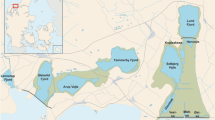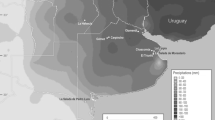Abstract
This paper introduces a series of contributions to the ninth meeting of the International Association of Phytoplankton Taxonomy and Ecology, held in Belgium during July, 1993. It draws from the original papers a synthesis which supports the view that the successful species in rivers and turbid shallow lakes are selected primarily on their ability to survive high-frequency irradiance fluctuations as they are circulated through steep light gradients. The selective distinction is less than that which discriminates between plankton of deep lakes and shallow lakes or even between clear and turbid shallow ones. River plankton is, however, dependent on fast growth rates but its survival in rivers is aided by a suite of water-retentive mechanisms. The ecology of turbid systems is dominated by physical interactions, those biotic interactions traditionally believed to regulate limnetic communities being suppressed and rarely well-expressed.
Similar content being viewed by others
References
Barone, R. & L. Naselli Flores, 1994. Phytoplankton dynamics in a shallow, hypertrophic reservoir (Lake Arancio, Sicily). Hydrobiologia, 289: 199–214.
Billen, G., J. Garnier & Ph. Hanset, 1994. Modelling phytoplankton development in whole drainage networks: the RIVER-STRAHLER model applied to the Seine River system. Hydrobiologia, 289: 119–137.
Carling, P. A., 1992. In-stream hydraulics and sediment transport. In P. Calow & G. E. Petts (eds), The rivers handbook, Vol. I. Blackwell Scientific Publications, Oxford: 101–125.
Carpenter, S. R., 1988. Complex interactions in lake communities. Springer Verlag, New York.
Descy, J.-P., 1987. Phytoplankton composition and dynamics in the River Meuse (Belgium). Archiv Hydrobiol. Suppl. 78: 225–245.
Descy, J.-P., 1993. Ecology of the phytoplankton of the River Moselle; effects of disturbances on community structure and diversity. Hydrobiologia 249: 111–116.
Descy, J.-P. & V. Gosselain, 1994. Development and ecological importance of phytoplankton in a large, lowland river (River Meuse, Belgium). Hydrobiologia 289: 139–156.
Dokulil, M. T., 1994. Environmental control of phytoplankton productivity in turbulent, turbid systems. Hydrobiologia 289: 65–72.
Gosselain, V., J.-P. Descy & E. Everbecq, 1994. The phytoplankton community of the River Meuse, Belgium: seasonal dynamics (year 1992) and the possible incidence of zooplankton grazing. Hydrobiologia, 289: 179–191.
Hynes, H. B. N., 1970. The ecology of running waters. University of Liverpool Press, Liverpool, 555 pp.
Izaguirre, I. & A. Vinocur, 1994. Algal assemblages from shallow lakes of the Salado River Basin. Hydrobiologia, 289: 57–64.
Jacobsen, B. A., 1994. Bloom formation of Gloeotrichia echinulata and Aphanizomenon flos-aquae in a shallow, eutrophic, Danish lake. Hydrobiologia 289: 193–197.
Kiss, K. T., É. Ács & K. Kovács, 1994. Ecological observations on Skeletonema potamos (Weber) Hasle in the River Danube, near Budapest (1991–1992, daily investigations). Hydrobiologia 289: 163–170.
Kiss, K. T. & J. Kristiansen, 1994. Silica-scaled chrysophytes (Synurophyceae) from some rivers and shallow lakes in Hungary. Hydrobiologia, 289: 157–162.
Köhler, J., 1994. Origin and succession of phytoplankton in a river-lake system (Spree, Germany). Hydrobiologia, 289: 73–83.
O'Farrell, I., 1994. Comparative analysis of the phytoplankton of fifteen lowland fluvial systems of the River Plate Basin (Argentina). Hydrobiologia, 289: 109–117.
Padisák, J. & M. Dokulil, 1994. Meroplankton dynamics in a saline, turbulent, turbid shallow lake (Neusiedlersee, Austria and Hungary). Hydrobiologia 289: 23–42.
Prygiel, J. & M. Leitão, 1994. Cyanophycean blooms in the reservoir of Val Joly (northern France) and their development in downstream rivers. Hydrobiologia 289: 85–96.
Reynolds, C. S., 1988. Potamoplankton: paradigms, paradoxes and prognoses. In F. E. Round (ed.), Algae and the aquatic environment. Biopress, Bristol: 285–311.
Reynolds, C. S., 1992. Algae. In P. Calow & G. E. Petts (eds), The rivers handbook Vol. I. Blackwell Scientific Publications, Oxford: 195–215.
Reynolds, C. S., 1994. The long, the short and the stalled: on the attributes of phytoplankton selected by physical mixing in lakes and rivers. Hydrobiologia 289: 9–21.
Reynolds, C. S., P. A. Carling & K. Beven, 1991. Flow in river channels: new insights into hydraulic retention. Archiv. Hydrobiol. 121: 171–179.
Reynolds, C. S. & M. S. Glaister, 1993. Spatial and temporal changes in phytoplankton abundance in the upper and middle reaches of the River Severn. Archiv. Hydrobiol. (Suppl.) 101: 1–22.
Rojo, C., M. Alvarez Cobelas & M. Arauzo, 1994. An elementary, structural analysis of river phytoplankton. Hydrobiologia 289: 43–55.
Schmidt, A., 1994. Main characteristics of phytoplankton of the southern Hungarian section of the River Danube. Hydrobiologia 289: 97–108.
Stoyneva, M. P., 1994. Shallows of the lower Danube as additional sources of potamoplankton. Hydrobiologia 289: 171–178.
Strahler, A. N., 1957. Quantitative analysis of watershed geomorphology. Transactions of the American geophysical Union 38: 913–920.
Vannote, R. L., G. W. Minshall, K. W. Cummins, J. R. Sedell & C. E. Cushing, 1980. The river continuum concept. Can. J. Fish. aquat. Sci., 37: 130–137.
Wawrik, F., 1962. Zur Frage: Führt der Donaustrom autochtones Plankton? Archiv Hydrobiol. (Suppl.) 27: 28–35.
Welch, E. G., 1952. Limnology (2nd edn). McGraw-Hill, New York, 538 pp.
Williams, L. G., 1964. Possible relationships between plankton-diatom species numbers and water quality estimates. Ecology, 45: 809–823.
Williams, L. G., 1966. Dominant planktonic rotifers of major water-ways of the United States. Limnol. Oceanogr. 11: 83–91.
Author information
Authors and Affiliations
Rights and permissions
About this article
Cite this article
Reynolds, C.S., Descy, J.P. & Padisák, J. Are phytoplankton dynamics in rivers so different from those in shallow lakes?. Hydrobiologia 289, 1–7 (1994). https://doi.org/10.1007/BF00007404
Issue Date:
DOI: https://doi.org/10.1007/BF00007404




